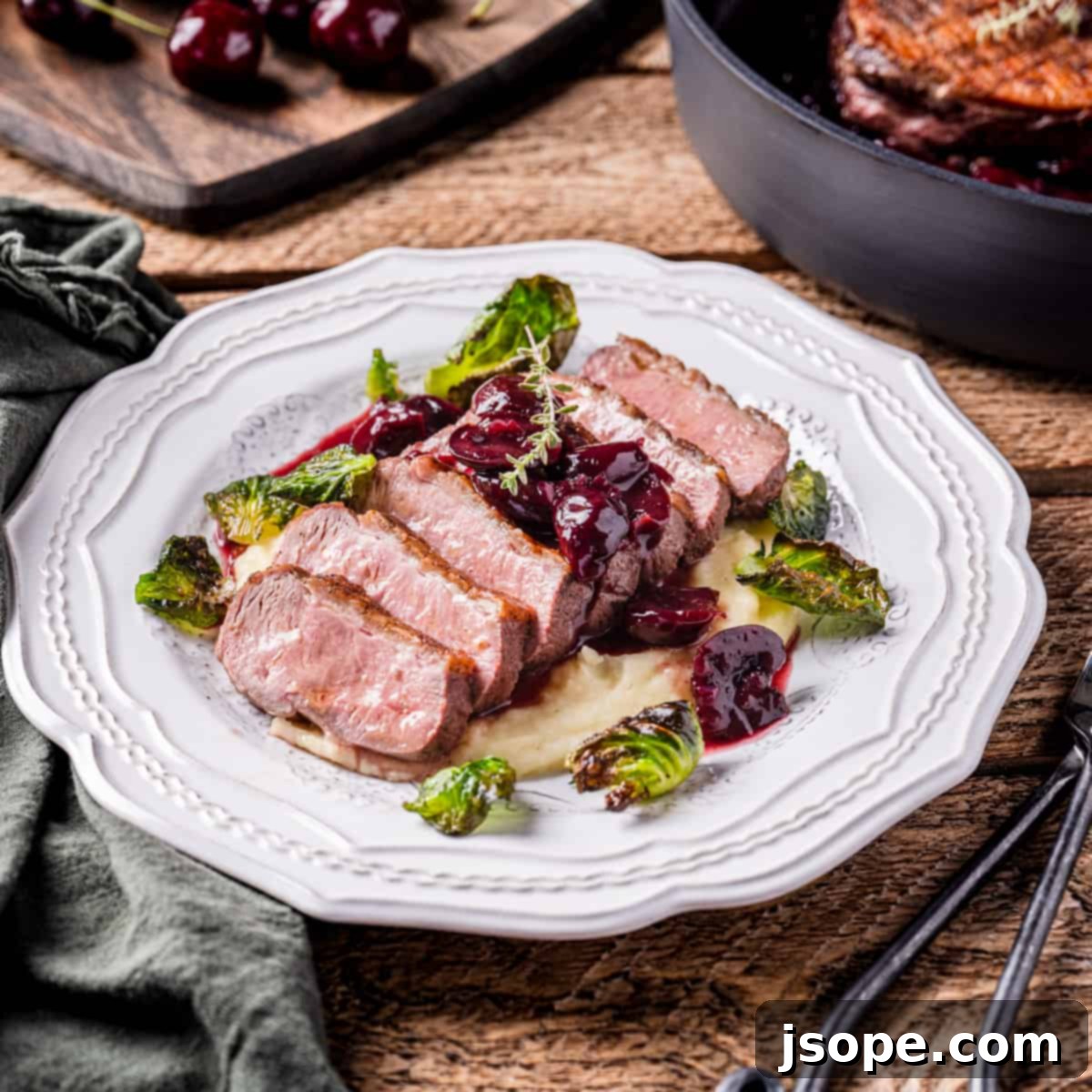Pan Seared Duck with Exquisite Cherry Port Sauce: A Culinary Masterpiece
Embark on a culinary journey with our exquisite Pan Seared Duck Breast, beautifully complemented by a luscious Cherry Port Sauce. This dish elevates the classic pairing of duck and cherries by infusing a sophisticated port wine reduction, creating a sauce that is both elegant and incredibly flavorful. It’s a truly beautiful dish that promises to impress, yet remains surprisingly straightforward to prepare in your own kitchen. Whether you’re a seasoned chef or a home cook eager to try something new, this recipe offers a gourmet experience without the fuss, making it perfect for special occasions or a luxurious weeknight meal.
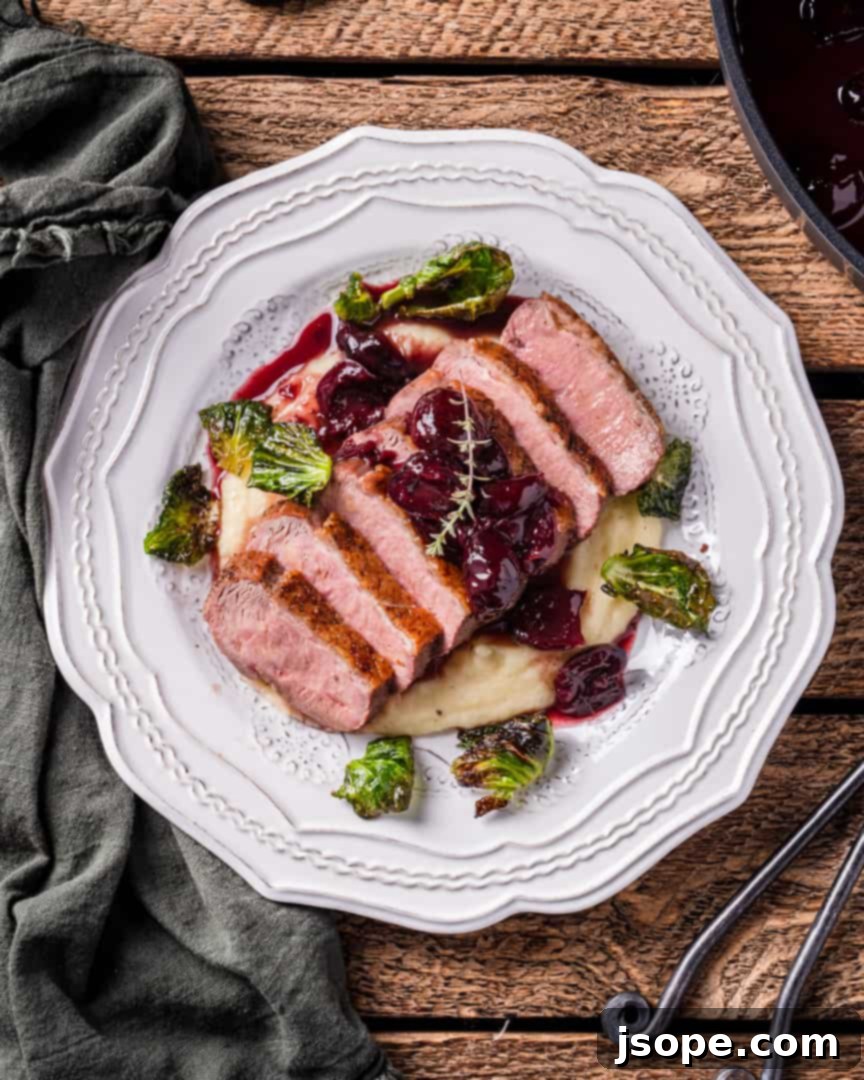
Selecting the Perfect Duck Breasts for Your Dish
Choosing the right duck breast is the first step towards a truly exceptional meal. While wild duck offers a distinct, often gamey flavor, our focus here is on farm-raised duck, which is more readily available and offers consistent quality. You can typically find high-quality duck breasts online, in specialty grocery stores, or directly from local farmers’ markets. Understanding the common breeds available in the United States will help you select the one best suited to your palate and the desired outcome for this recipe.
Popular Farm-Raised Duck Breeds in the USA:
- Pekin (also known as Long Island Duck): This is arguably the most widely consumed duck in the U.S. Pekin duck meat is characterized by its mild flavor, tender texture, and versatility, making it adaptable to a wide array of culinary traditions. It’s an excellent choice for those new to cooking duck or who prefer a less pronounced duck flavor.
- Muscovy: Recognizable by its larger breasts and distinct appearance, Muscovy duck has thinner skin with a generous fat layer. Its meat is darker, richer, and boasts a much stronger, more intense duck flavor compared to Pekin. Often favored by duck connoisseurs, Muscovy is a fantastic option if you desire a truly robust duck experience. Its larger breasts also mean more meat per serving.
- Moulard: A hybrid breed resulting from a cross between Muscovy and Pekin ducks, Moulard is renowned as the primary breed raised for foie gras in France. The breasts, often called “magrets,” are dense, incredibly rich, plump, and carry a strong, distinctive flavor. Magrets are typically thicker and yield more rendered fat, which can be saved for other culinary uses.
- D’Artagnan Rohan: While not a distinct breed in itself, Rohan duck is a proprietary cross developed by D’Artagnan, a leading gourmet food supplier. It’s a cross between a Mallard and a Pekin, offering smaller, exceptionally tender breasts with a delicate, mild flavor profile. We often prefer Rohan for its superior tenderness and subtle taste, using it in this recipe and many of our other duck preparations. Mallard ducks, incidentally, are common wild ducks found across the USA, with males often identified by their distinctive green heads.
When selecting your duck breasts, look for plump, firm meat with an intact skin layer. The skin should be uniform in color and free from blemishes. For optimal results in this recipe, which focuses on a delicate balance with the cherry port sauce, we highly recommend a milder, more tender duck such as Rohan or Pekin, though Muscovy or Moulard can certainly be used if you prefer a bolder duck flavor.
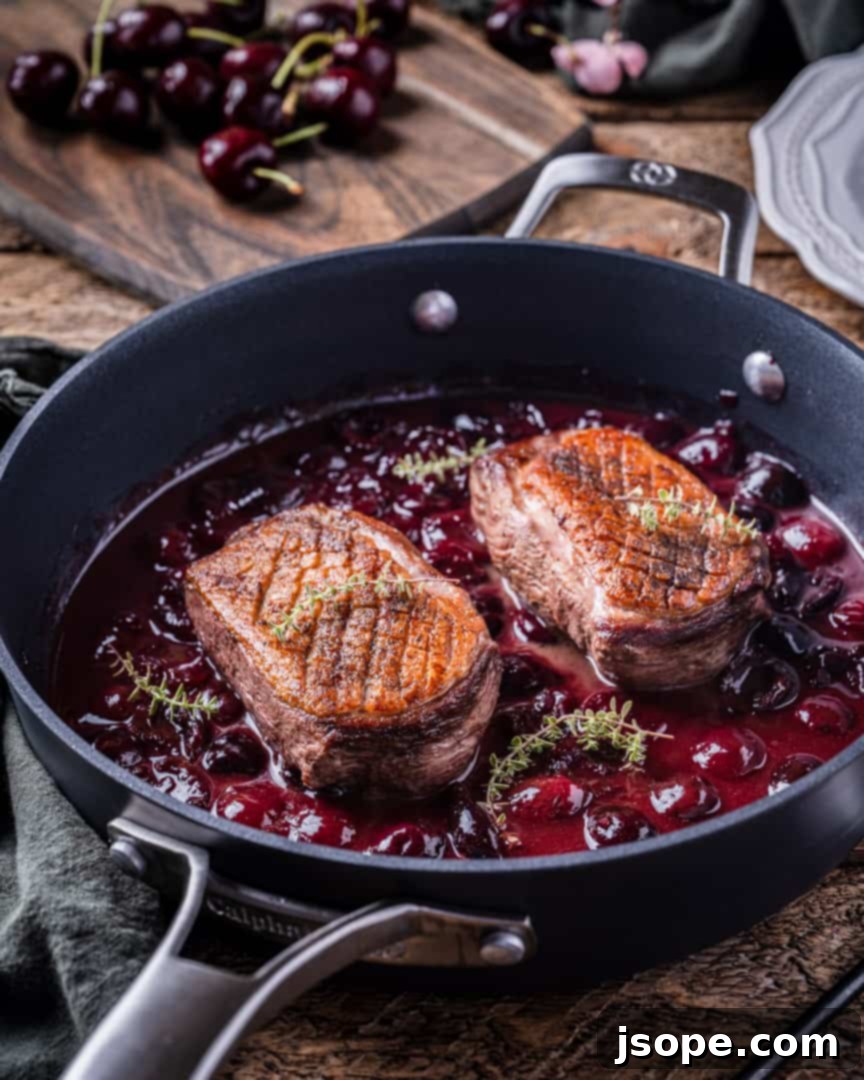
Mastering the Art of Cooking Duck Breasts
Cooking duck breasts to perfection might seem intimidating, but with a few essential techniques and a bit of patience, you can achieve restaurant-quality results at home. Unlike chicken or other poultry, duck is often treated more like a red meat in terms of desired internal temperature, typically served medium-rare to medium.
When it comes to internal temperatures, duck breast is unique. While chicken must be cooked to 165°F (74°C) for safety, duck is best enjoyed when cooked to a lower temperature, similar to beef. Our preference is a beautiful medium-rare to medium, aiming for an internal temperature of 133-135°F (56-57°C) at the thickest part of the breast. This allows for a few degrees of carryover cooking once removed from the heat, landing just under our ideal 140°F (60°C). However, you can adjust this to your liking, as duck is safe and delicious at various levels of doneness. A reliable meat thermometer is your best friend here.
For pan searing, a high-quality nonstick skillet is ideal. The durable surface helps achieve that coveted crispy skin without excessive sticking, making cleanup a breeze. While the specific brand mentioned in the original text is a good choice, any reliable nonstick pan will work wonderfully to ensure even cooking and easy handling of the duck breasts.
Achieving Irresistibly Crispy Duck Skin
The hallmark of a perfectly pan-seared duck breast is its incredibly crispy, golden-brown skin. This is achieved through a process called “rendering,” where the thick layer of fat beneath the skin slowly melts away, leaving behind a thin, crispy crust. Here’s how to master this crucial step:
- Scoring the Skin: Begin by scoring the fatty side of the duck breast. Using a sharp knife, make parallel cuts about ¼ inch apart, then repeat perpendicular to create a cross-hatch pattern. Be careful to cut only through the skin and fat, without piercing the meat itself. This scoring allows the fat to render more efficiently and prevents the skin from shrinking and buckling during cooking.
- Seasoning and Drying: Generously season both sides of the scored duck breast with kosher salt and freshly ground black pepper. Then, place the duck breasts skin-side up on a wire rack set over a plate or baking sheet. Refrigerate them uncovered for at least 30 minutes, or ideally for several hours (up to 4-6 hours). This critical step allows the surface moisture to evaporate, which is key to achieving maximum crispness when cooked. Remember to remove the duck from the refrigerator about 15-20 minutes before cooking to allow it to come closer to room temperature for more even cooking.
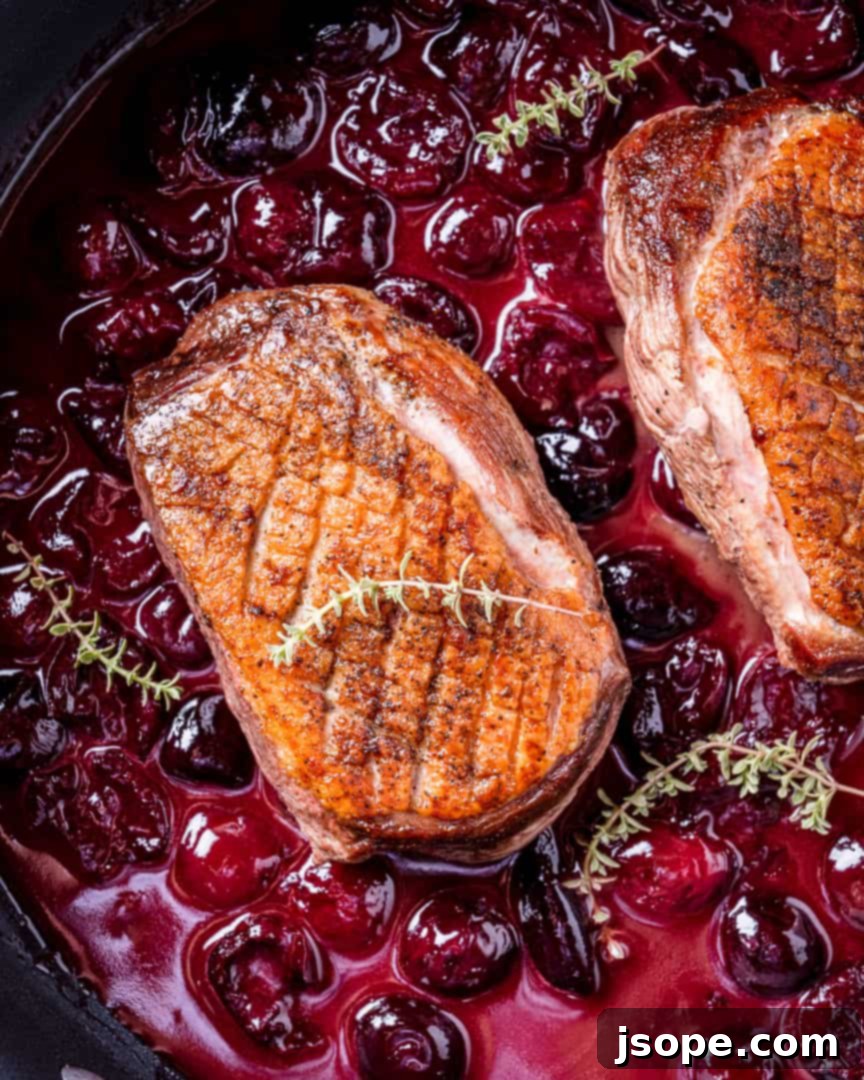
The cooking process itself is equally important. Start with a cold pan – this is a non-negotiable step for duck. Place the duck breasts skin-side down in the cold pan, then turn the heat to medium-low. This gradual heating allows the fat to render slowly and evenly, preventing the skin from burning before the fat has had a chance to melt. Cook the duck on the skin side for approximately 10-12 minutes, or until the skin is deeply golden brown and much of the fat has rendered into the pan. The exact timing will depend on the thickness of the fat cap and the size of your duck breast. You’ll see the fat accumulate in the pan – this is liquid gold!
Once the skin is crispy and golden, flip the duck breast and cook on the meat side for only about 2-3 minutes, just enough to bring the internal temperature to your desired doneness, around 135°F (57°C) for medium-rare. During these final minutes, we love to baste the duck with the rendered fat from the pan. Spooning this flavorful fat over the meat keeps it succulent and infuses it with even more rich duck flavor.
After cooking, transfer the duck breasts to a cutting board and allow them to rest for 5-10 minutes. Resting is paramount: it allows the juices to redistribute throughout the meat, ensuring a tender, moist, and flavorful result. Slicing too early will cause the juices to run out, leading to dry duck. Don’t forget to save the precious rendered duck fat! It’s fantastic for roasting potatoes, searing vegetables, or adding flavor to countless other dishes. Duck fat potatoes are a revelation you absolutely must try!

Crafting the Exquisite Cherry Port Sauce
The Cherry Port Sauce is the star that truly elevates this pan-seared duck to gourmet status. This semi-sweet and tangy sauce, with just the right amount of tart balance, perfectly cuts through the richness of the duck, creating a harmonious and unforgettable flavor profile. It’s incredibly easy to make with just a few quality ingredients.
The foundation of this luscious sauce relies on the beautiful synergy of sweet cherries and a robust tawny port wine. A touch of finely diced shallot provides an aromatic base, while a hint of honey enhances the natural sweetness of the cherries without overpowering them. Finally, cold butter is whisked in at the end to emulsify the sauce, giving it a silky texture and a rich, glossy finish.
For the best results, use fresh, ripe cherries when they are in season. If fresh cherries are unavailable, high-quality frozen pitted cherries can be a suitable substitute. The key is to reduce the port wine and cherry mixture until it thickens slightly and the flavors meld into a concentrated, vibrant essence. This reduction process intensifies the sweetness of the fruit and the complex notes of the port, creating a truly irresistible sauce.
Other Decadent Sauces for Duck
While our Cherry Port Sauce is a showstopper, duck is incredibly versatile and pairs well with a variety of flavor profiles. If you’re looking to explore other options, consider these fantastic alternatives:
- Blood Orange and Thyme Glaze: A bright, citrusy glaze with aromatic thyme offers a refreshing contrast to the duck’s richness.
- Blueberry Thyme Red Wine Reduction: Similar to our cherry sauce, but with the unique sweetness and tartness of blueberries, deepened by a red wine reduction.
Perfect Pairings: What to Serve with Pan Seared Duck Breast
Duck’s rich flavor and succulent texture make it a versatile canvas for a wide array of side dishes and garnishes. The goal is often to balance its richness with elements that offer contrasting textures or flavors, such as acidity, sweetness, or earthy notes. Our Pan Seared Duck with Cherry Port Sauce calls for accompaniments that can stand up to its bold flavors while still allowing the duck to shine.
Recommended Side Dishes:
- Creamy Potato Puree: A smooth, velvety potato puree provides a comforting and luxurious base that soaks up the exquisite cherry port sauce beautifully. Think classic mashed potatoes, but elevated with plenty of butter and cream for an ultra-silky texture.
- Crispy Brussels Sprout Leaves: To add a delightful textural contrast, crispy Brussels sprout leaves are a fantastic choice. Simply separate the leaves, toss them with a little olive oil, salt, and pepper, and roast or pan-fry until crisp and slightly charred. Their slight bitterness offers a lovely counterpoint to the duck.
- Roasted Asparagus or Charred Broccolini: These green vegetables offer freshness and a subtle earthiness. Roasted asparagus spears, perhaps with a sprinkle of Parmesan and lemon zest, or broccolini charred quickly in a hot pan, provide vibrant color and a healthy component to the meal.
- Wild Rice Pilaf: For a heartier side, a wild rice pilaf with sautéed mushrooms or dried cranberries can be an excellent choice. Its nutty flavor and chewy texture complement the duck wonderfully.
- Glazed Root Vegetables: Carrots, parsnips, or sweet potatoes, roasted and lightly glazed with a touch of maple syrup or honey, offer natural sweetness that harmonizes with the cherry port sauce.
Wine Pairings for Pan Seared Duck with Cherry Port Sauce:
Selecting the right wine can elevate your dining experience even further. For this rich duck dish with a fruit-forward port sauce, consider wines that can complement both the meat and the sauce:
- Pinot Noir: A classic pairing for duck, Pinot Noir’s earthy notes, red fruit flavors, and bright acidity beautifully complement the richness of the duck and the sweetness of the cherry port sauce. Look for a Burgundy or an Oregon Pinot Noir.
- Zinfandel: For those who prefer a bolder red, a fruit-forward Zinfandel with notes of plum and berry can stand up to the sauce and duck’s flavor, offering a delightful counterpoint.
- Beaujolais (Cru): Lighter than Pinot Noir but still full of bright red fruit and earthy undertones, a Cru Beaujolais (such as Morgon or Fleurie) can be a fantastic, food-friendly choice.
- Dessert Port (to finish): While you use tawny port in the sauce, a glass of a sweeter, older Tawny Port after the meal can be a delightful way to echo the flavors of the sauce and conclude your dining experience.
Ultimately, the best side dishes and wine pairings are those you enjoy most. Feel free to experiment and discover your own perfect combinations that enhance this magnificent duck dish.
Savor Every Moment!
We hope you thoroughly enjoy preparing and savoring this incredible Pan Seared Duck with Cherry Port Sauce! It’s a dish that embodies elegance and comfort, perfect for creating memorable dining experiences. We love hearing from our community, so if you try this recipe and find it as delightful as we do, please consider leaving us a 5-star rating and a comment below. Your feedback and support mean the world to us!
Don’t forget to share your culinary creations with us on Instagram by tagging @cooking_with_wine! We love to see your interpretations of our recipes and connect with fellow food enthusiasts.
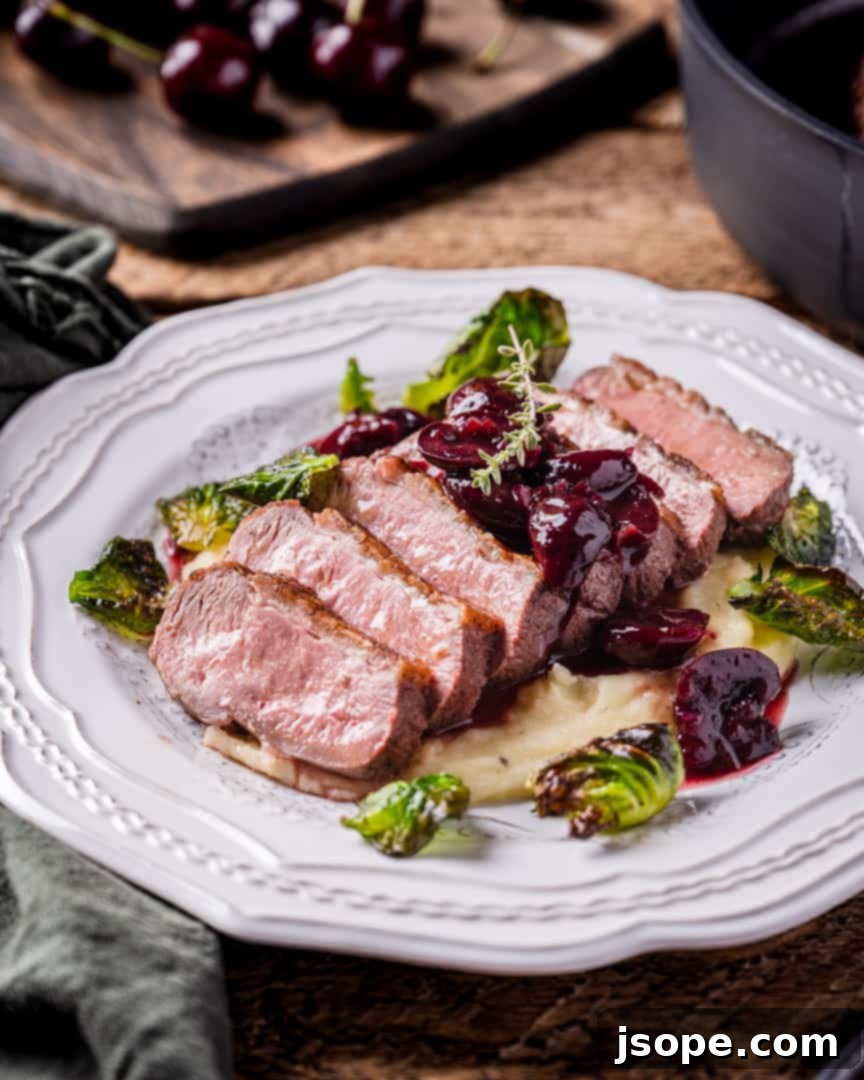
Craving More Culinary Adventures?
If you loved this recipe, we invite you to explore more of our unique and delicious dishes. Here are a few suggestions:
- Pink Peppercorn Chicken with Golden Berry Tarragon Cream Sauce
- Blood Orange Shrimp and Creamy Cheese Grits
- Grapefruit Herb Chicken with Supreme Sauce
- Chicken Piccata with Caper Lemon Butter Sauce
📖 Recipe: Pan Seared Duck with Cherry Port Sauce
A delicious and quick pan-seared duck breast with irresistible crispy skin, paired with an unforgettable semi-sweet and tangy cherry and port wine sauce.
45 mins
20 mins
1 hr 5 mins
Dinner
French
4 servings
445 kcal
Ingredients
For the Duck
- 4 duck breasts (4-6 oz each)
- 1 teaspoon kosher salt
- ½ teaspoon black pepper
For the Sauce
- 1 tablespoon olive oil
- 1 medium shallot – finely diced
- 1 cup tawny port
- 1 ½ cup pitted and halved cherries
- 1 teaspoon kosher salt
- ¼ teaspoon black pepper
- 1 teaspoon honey
- 4 tablespoon unsalted butter – cold and cubed into 8 pieces
Instructions
Prepare the Duck
- Score the fat side of each duck breast by cutting through the skin and most of the fat, ensuring you do not cut into the flesh. A cross-hatch pattern, with cuts approximately ¼” apart, works best for even rendering.
- Season both sides of the duck breasts generously with salt and pepper. Place them on a wire rack set over a plate and refrigerate uncovered for a minimum of 30 minutes, or ideally for several hours, to allow the skin to dry out. Remove from the refrigerator 15 minutes before cooking.
- When ready to cook, place your duck breasts fat-side down in a cold pan. Place the pan over medium heat and cook slowly for about 10-12 minutes, or until the skin is beautifully crispy and golden brown, and most of the fat has rendered.
- Flip the duck breast over and cook on the meat side for approximately 2-3 minutes, or until an internal temperature of around 135°F (57°C) is reached.
- Remove the duck to a cutting board and let it rest for 5-10 minutes before slicing. The internal temperature will rise slightly during resting, reaching approximately 140°F (60°C) for a perfect medium-rare.
Prepare the Sauce
- In a small saucepan or sauté pan, heat the olive oil over medium heat. Add the finely diced shallot and cook until it just begins to brown around the edges, becoming fragrant and slightly softened.
- Next, add the tawny port, pitted and halved cherries, salt, and pepper to the pan. Stir well to combine.
- While stirring, add the honey, ensuring it fully dissolves and integrates into the liquid.
- Continue to cook the sauce over medium heat until the liquid has reduced by about half, becoming slightly thickened and syrupy.
- Remove the pan from the heat. Gradually stir in the cold, cubed unsalted butter, one piece at a time, until each piece is fully incorporated and the sauce is smooth and glossy.
- Serve the warm Cherry Port Sauce generously over the sliced, rested duck breasts.
Video Reference
For a visual guide on preparing this dish, you can watch a helpful video: https://www.instagram.com/reel/CvHwpWlt32F/?igsh=YWVzaHBzeTlxeHdn
Nutrition Information
Carbohydrates: 19g
Protein: 29g
Fat: 21g
Saturated Fat: 10g
Polyunsaturated Fat: 2g
Monounsaturated Fat: 7g
Trans Fat: 0.5g
Cholesterol: 139mg
Sodium: 1251mg
Potassium: 580mg
Fiber: 1g
Sugar: 13g
Vitamin A: 460 IU
Vitamin C: 13mg
Calcium: 24mg
Iron: 7mg
Keywords
cherry, Duck, port, pan seared duck breast, cherry port sauce, crispy duck skin, gourmet duck recipe
Tried this recipe?
Let us know how it was!
Do You Love Our Recipes?
We pour our passion into providing you with delicious, high-quality **FREE** recipes here on Cooking With Wine. If you appreciate our content and wish to support our continuous efforts to bring you more culinary inspiration, any contribution you feel comfortable with would be immensely valued.
We are committed to sharing delightful recipes regardless, so please know there is **no obligation** to contribute. Every bit of support, however small, is genuinely appreciated and helps us keep our kitchen vibrant and our content flowing.
Thank you for being an integral part of our community! You are the very reason we do what we do, and your enthusiasm for food fuels our creativity!
